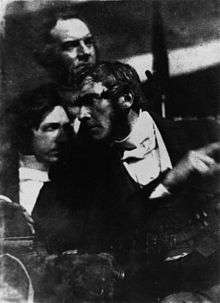Robert Cunningham Graham Spiers
Robert Cunningham Graham Spiers or Speirs FRSE (1797–1847) was a 19th-century Scottish advocate and prison reformer. He is often confused with his father's first legitimate son Robert Bontine Cunningham Graham (1799–1863). In later life he is largely referred to simply as Graham Spiers.

Life
He was born Robert Cunningham Cunninghame Graham on 14 September 1797 (or 1799) the son of William Cunningham Cunninghame Graham (1775–1845) of Gartmore near Lake of Menteith.[1] His father married Robert's mother, Ann Dickson (1782–1811) in December 1798. So the 1799 birth date is possibly a cover for an illegitimate birth in 1797. This would also help to cover his mother's exceptionally young age (15).[2]
He studied law and qualified as an advocate in 1820. In 1835 he became Sheriff of Elgin. In 1840 he became Sheriff of Edinburgh and remained in that role until death.
In 1841 he was elected a Fellow of the Royal Society of Edinburgh. His proposer was David Welsh.[3]
In the Disruption of 1843 he is listed as one of the church elders who left the Church of Scotland to join the Free Church of Scotland.[4]

He lived his final years at Granton House in north Edinburgh.[5]
He died on Christmas Eve, 24 December 1847. He is buried in Grange Cemetery in south Edinburgh. The grave lies in the centre of the north wall. The grave (and other sources) give his wife as Catherine Ann Grant, daughter of Francis Grant of Kilgraston.
Family
In 1824 he married Frances Laura Spiers (1800-1877), daughter of Peter Spiers of Culcreuch Castle and was thereafter known as Robert Cunningham Graham Spiers (or simply as Graham Spiers). He lived with his in-laws at a very large Georgian townhouse at 46 Great King Street.[6] From around 1830 all records infer he was the son rather than son-in-law of Peter Spiers.
His seven children were all known simply as Graham rather than Graham-Spiers.
His grandchildren included Robert Bontine Cunningham Graham.
References
- https://www.ucl.ac.uk/lbs/person/view/2146634582
- http://www.clanmacfarlanegenealogy.info/genealogy/TNGWebsite/getperson.php?personID=I10819&tree=CC
- Biographical Index of Former Fellows of the Royal Society of Edinburgh 1783–2002 (PDF). The Royal Society of Edinburgh. July 2006. ISBN 0 902 198 84 X.
- Acts of the General Assembly of the Free Church of Scotland 1843
- Edinburgh Post Office Directory 1846
- Edinburgh Post Office Directory 1825
- https://www.nationalgalleries.org/art-and-artists/67716/robert-cunningham-graham-speirs-1797-1847-advocate-sheriff-midlothian-leading-free-churchman-and